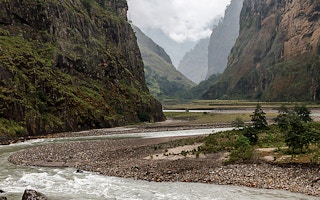A wetter future awaits South Asia, says a new study based on global climate change models that informed the fifth assessment report of the UN’s Intergovernmental Panel on Climate Change.
The South Asia region will see a 20–30 per cent increase in mean annual runoff for the period 2046–2075 relative to the study baseline period of 1976–2005, says Hongxing Zheng, corresponding author of the study published this month (August) in the Journal of Hydrology: Regional Studies. The study was carried out by the Commonwealth Scientific and Industrial Research Organisation, Australia.
“We also discovered that the percentage change in precipitation may amplify by 1.5–2 per cent in wet areas and by more than two per cent in dry areas,” Hongxing tells SciDev.Net.
South Asia is home to 54 rivers of varying sizes linked to the Indus, Ganges and Brahmaputra river basins, all originating in China’s Tibet Autonomous Region. While the Indus basin connects China with Afghanistan, India and Pakistan, the Brahmaputra and Ganges basins connect Bangladesh, Bhutan, China, India and Nepal.
“A spike in mean annual runoff of about 10 per cent is projected for the Indus, Tibetan Plateau and Arakan Coast regions, and about 15 per cent in the Ganges-Brahmaputra, Deccan Plateau and Ghats Coast regions,” Hongxing says, adding that the spike will be over 20 per cent in the Narmada-Tapti region and Sri Lanka.
The change will be driven by higher temperatures from global warming, leading to more rain, according to the study. Average daily temperatures would rise by 2.9–4 degrees Celsius in 2046‒2075, relative to the baseline. It also says the winter season will be slightly warmer and the summer seasons may see noticeably higher temperatures, especially in the northern (high altitude) regions.
“
We also discovered that the percentage change in precipitation may amplify by 1.5–2 per cent in wet areas and by more than two per cent in dry areas.
Hongxing Zheng, co-author of study, Journal of Hydrology: Regional Studies
Arun Shrestha, manager of the river basins programme of the International Centre for Integrated Mountain Development Centre (ICIMOD), Kathmandu, says that until recently hydrologists and climatologists perceived runoffs across South Asia as reducing due to climate change. “But field and satellite imagery show that water availability is likely to increase — this is consonant with the new study on runoff scenarios for all the rivers.”
Managed properly, Shrestha says, increased runoffs could help socio-economic growth and poverty reduction in countries of South Asia which largely rely on farming. However, failing to do so will exacerbate floods, land erosion, water logging, droughts and related impacts, he warns.
Food security and farm-based livelihoods expert at ICIMOD, Golam Rasul, suggests “investing in flood-resilient farming systems, flood-tolerant crop varieties and infrastructure as well as collaboration among South Asian countries for joint river basin management and early flood-warning systems to mitigate projected impacts.”
This article was originally published on SciDev.Net. Read the original article.

















